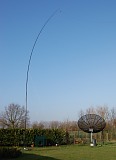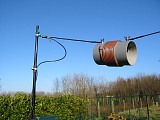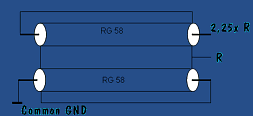


As a GPA has a low feed resistance (about 35R at 1/4 wave, about 20R as shortened on 160m), the antenna is fed through a 1 to 2,25 balun to feed it by 50R coax. The balun is wound (5 or 6 turns bifilar) on a large 43 material ferrite core, here with RG-58 (no problems with 800w), but better would be RG-400 (this coax is rated at 5 kW). The result is a very flat SWR curve and 1:1 at resonance. You can find details how to construct this balun on the valuable site of ON9CVD Bob This balun is normally used to step up impedance from 50R to 112.5R, but can be used to step down as well !
